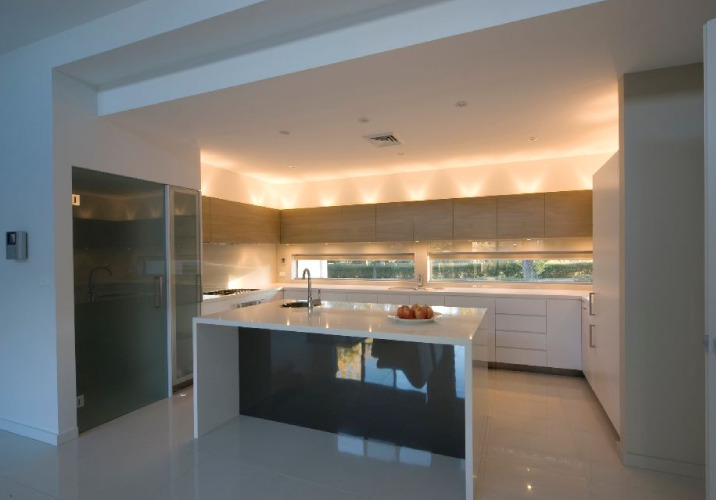Our kitchens are communal spaces for creativity and nourishment. Here are our top kitchen lighting ideas that combine style with energy-saving technology to enhance the culinary experience and create an ambient space the entire family can enjoy.
Three different kinds of kitchen lights
There are three major types of kitchen lights to mention:
General lighting
General lighting illuminates the entire room. Mostly, this will be overhead lighting, which can be either recessed lighting or a hanging light.
Task lighting
Task lighting is that which is designed for specific purposes. It is an essential feature in every kitchen, making it easier to perform tasks in some of the most common areas of the kitchen such as the bench, sink and stove. Don’t be restrained to one central light source but consider the unique way your family uses the kitchen and add a mixture of light sources that will adjust to your specific tasks.
Mood and accent lighting
Mood and accent lighting is key to creating an inviting atmosphere in a kitchen. Without it, any expensive and luxurious features might go under the radar and be missed.

Light switches
General lighting should have switches at all entry and exit points. Rather than simply using a single switch for all task lighting fixtures, have separate ones for different areas. In U-shaped kitchens, for example, include separate lights and switches on both sides of the U. If there is an island in the middle of the room, it is a good idea to instal a specific light to illuminate it, with a separate switch to the main general overhead lighting in the room. Dimmer switches are important for accent lights to allow you to create different moods when you want.
Space savers
Lampshades and lanterns take up precious floor or bench space in small kitchens but opting for ceiling or wall lighting fixtures can help illuminate the space in a functional and trendy way.
In tight corners, dark pantries or small spaces, illuminate with stylish light alternatives. Rope lights or strip lights are practical, space-saving solutions in those tight, tricky kitchen spots. Adding a row of LED lights to your pantry, cabinets or narrow shelves is a stylish and practical way to brighten dark corners.
Contact local kitchen experts
LED strip lights
LED strip lights are small lights installed on a strip and spaced so that they provide even light. Strips can be used separately or joined together, depending on the length of the area you want to light.
Because of their qualities, LED strip lights are great choices for kitchen lighting. They are functional, modern and good for the environment because they use little energy to run and they do not emit heat. Add in the fact that they resist moisture and are very sturdy, and you have a perfect lighting choice for your kitchen.
They are also extremely cost-effective because the bulbs last so long some last longer than 40,000 hours! No more standing on ladders and changing bulbs LED strip lighting might last longer than your kitchen.
Pendant lights
Pendant lights use space efficiently and accentuate a focal point in your kitchen by positioning pendants over central areas of the kitchen to organise a small space. Avoid oversized pendants in a small kitchen space but opt for pendants with petite shades or sleek edges, rather than a wide cylindrical shape to complement your space. Pendants generally require higher ceilings so consider the height of your ceiling.

Sunlight
Sunlight is an ideal source of ambient light that is entirely free. Save space and utilise natural light in your home by removing upper cabinets in exchange for extra window space. Upper cabinets impede incoming light and without the obstruction, natural light will bathe your kitchen space with bright and ambient light during the day.
An electrician can help you pick out the perfect lighting fixtures to help you create the ideal kitchen. In fact, you can even find a lighting consultant to help you pick them out as well. Whatever you choose to do, never overlook the importance of lighting when doing kitchen renovations. They really can make the difference between a boring, ordinary kitchen, and a truly spellbinding one.
